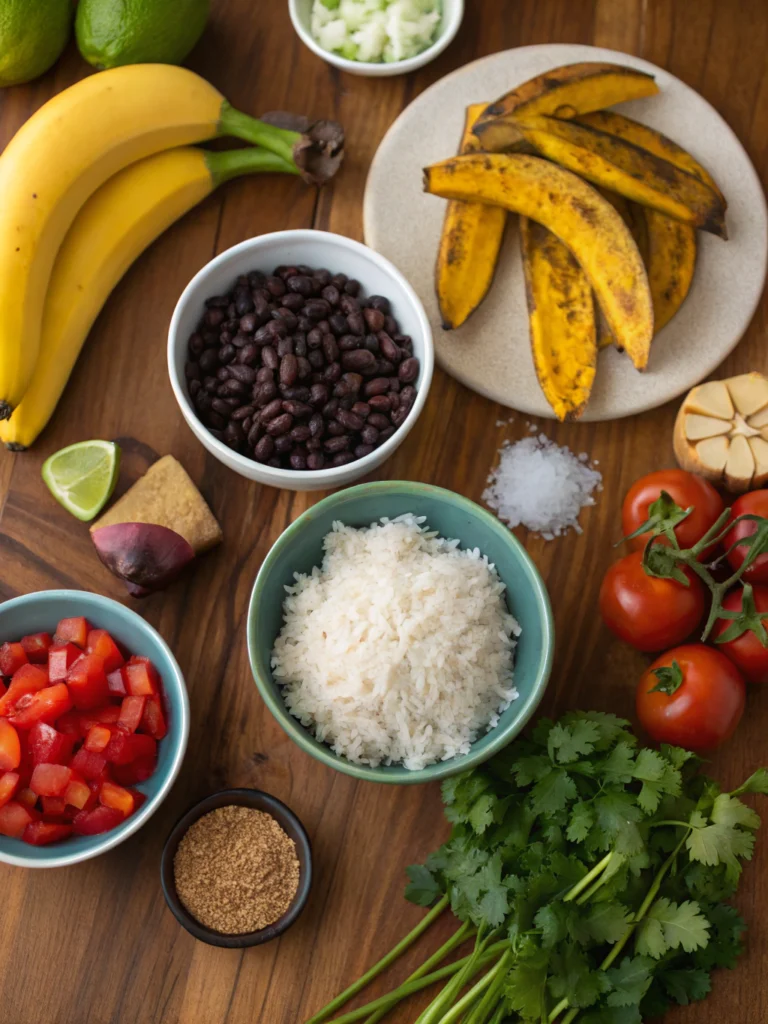Have you ever wondered why Puerto Rican cuisine captivates food lovers worldwide with its irresistible blend of Spanish, African, and Taíno influences? The secret lies in its perfect harmony of bold spices, fresh ingredients, and time-honored cooking techniques that tell the story of this vibrant Caribbean island.
Exploring Puerto Rican recipes opens a world of flavor that goes beyond the familiar. From hearty stews to crispy fritters, these dishes showcase the island’s rich culinary heritage that has evolved over centuries of cultural fusion.
Let’s dive into seven essential traditional Puerto Rican dishes that will transport your taste buds to the sunny shores of this beautiful island. Each recipe carries generations of history while remaining accessible for home cooks looking to expand their culinary horizons.
1. Arroz con Gandules (Rice with Pigeon Peas)
Often called Puerto Rico’s national dish, Arroz con Gandules combines rice, pigeon peas, and pork in a savory blend seasoned with sofrito and achiote oil. This one-pot wonder appears at virtually every holiday table and family gathering across the island.
Ingredients List

- 2 tablespoons olive oil
- ¼ cup sofrito (blend of peppers, onions, garlic, and herbs)
- ¼ pound diced ham or pork
- 1 packet sazón with achiote
- 1 tablespoon adobo seasoning
- 1 can (15 oz) pigeon peas (gandules), drained
- 2 cups medium-grain rice, rinsed
- 3½ cups chicken broth
- ½ cup olives with pimientos, sliced (optional)
- 2 bay leaves
Timing
- Preparation time: 15 minutes
- Cooking time: 40 minutes
- Total time: 55 minutes – significantly faster than many other traditional rice dishes that can take well over an hour to develop proper flavor.
Step-by-Step Instructions

Step 1: Prepare the Base
Heat olive oil in a large pot over medium heat. Add sofrito and sauté for 2-3 minutes until fragrant. Add diced ham or pork and cook until lightly browned, about 5 minutes. This creates the essential flavor foundation for the entire dish.
Step 2: Season the Mixture
Add sazón, adobo seasoning, and bay leaves to the pot. Stir well to coat the meat and sofrito mixture. The achiote in the sazón will give the rice its characteristic orange-yellow color that signals authentic preparation.
Step 3: Add Rice and Liquid
Add the rinsed rice to the pot and stir for 1-2 minutes to coat with the seasoned oil. Pour in chicken broth, drained pigeon peas, and olives if using. Stir gently to combine all ingredients.
Step 4: Cook to Perfection
Bring to a boil, then reduce heat to low. Cover and simmer for 25-30 minutes until rice is tender and liquid is absorbed. Resist the urge to stir during cooking – this ensures proper texture development.
Step 5: Rest and Serve
Remove from heat and let stand, covered, for 5 minutes. Fluff with a fork, removing bay leaves before serving. This resting period allows the flavors to settle and the texture to perfect itself.
2. Mofongo (Mashed Plantains with Garlic)
This beloved dish features fried green plantains mashed with garlic, chicharrones (pork cracklings), and olive oil. Mofongo can be served as a side dish or stuffed with seafood, chicken, or beef as a main course.
Ingredients List
- 4 green plantains, peeled and cut into 1-inch chunks
- Vegetable oil for frying
- 6 cloves garlic, minced
- ¼ cup pork cracklings (chicharrones), crushed
- 2 tablespoons olive oil
- Salt to taste
- ½ cup chicken broth (for serving)
Timing
- Preparation time: 20 minutes
- Cooking time: 15 minutes
- Total time: 35 minutes – a quick preparation compared to other starchy side dishes that often require 45-60 minutes.
3. Pernil (Roast Pork Shoulder)
A centerpiece of Puerto Rican celebrations, pernil is a slow-roasted pork shoulder marinated in a garlicky adobo. The extended cooking time creates the perfect contrast between crispy skin (cuero) and tender, juicy meat.
Ingredients List
- 7-8 pound pork shoulder (with skin on)
- 12 cloves garlic, minced
- 3 tablespoons olive oil
- 2 tablespoons white vinegar
- 1 tablespoon dried oregano
- 1 tablespoon adobo seasoning
- 2 teaspoons ground cumin
- 2 teaspoons salt
- 1 teaspoon black pepper
4. Pasteles (Meat-Filled Plantain and Root Vegetable Parcels)
These labor-intensive treats are especially popular during Christmas. Puerto Rican recipes for pasteles combine a masa (dough) made from plantains and root vegetables with a savory filling, all wrapped in banana leaves before boiling.
Nutritional Information
The average serving of these traditional dishes varies in nutritional content. Arroz con gandules provides approximately 350 calories per cup with 7g of protein and 5g of fiber. Mofongo delivers around 400 calories per serving with significant potassium from plantains. Pernil offers high protein content (approximately 30g per 4oz serving) but also contains 15-20g of fat, depending on the cut.
Most Puerto Rican recipes feature complex carbohydrates from rice, plantains, and root vegetables, providing sustained energy. The dishes typically contain 500-800mg of sodium per serving due to seasoning blends, which is approximately 25% of the recommended daily intake.
5. Tostones (Twice-Fried Plantain Slices)
These crispy plantain discs are a staple side dish. Green plantains are fried, smashed, then fried again to create a crunchy exterior with a tender interior. They’re often served with garlic sauce (mojo) for dipping.
6. Bacalaitos (Codfish Fritters)
These thin, crispy fritters made from salted codfish and seasoned batter are popular street food. The contrast between the crunchy exterior and the flavorful fish inside makes them irresistible snacks or appetizers.
7. Tembleque (Coconut Pudding)
This silky coconut dessert gets its name from the Spanish word “temblar” (to tremble) because of its delicate, wiggly texture. Simple yet elegant, tembleque is often garnished with cinnamon for a perfect end to any Puerto Rican meal.
Healthy, versatile, and family-approved, these 7 turkey and rice combinations are must-tries for any home cook.
Healthier Alternatives for the Recipes
Many Puerto Rican recipes can be adapted for modern dietary preferences without sacrificing authentic flavor. For arroz con gandules, use brown rice instead of white for increased fiber and nutrients. Reduce sodium by using low-sodium broth and fresh herbs to enhance flavor.
For mofongo, try baking or air-frying plantains instead of deep-frying. This reduces oil content by up to 70% while maintaining the satisfying texture. For pernil, trim visible fat before cooking and use a rack in the roasting pan to allow excess fat to drain.
Vegetarians can enjoy versions of these classics by substituting jackfruit for pork in pernil, using beans instead of meat in rice dishes, and creating plant-based sofrito as the flavor base for various recipes.
Serving Suggestions
Create a complete Puerto Rican feast by pairing complementary dishes. Serve pernil with arroz con gandules and a simple avocado salad for a traditional holiday meal. Mofongo pairs beautifully with a garlicky chicken broth or shrimp in creole sauce spooned over the top.
For casual gatherings, offer tostones with various dipping sauces like mayo-ketchup (a Puerto Rican favorite), garlic mojo, or guacamole. Complete any meal with tembleque or flancocho (flan-cake hybrid) for an authentic sweet ending.
Common Mistakes to Avoid
- Underseasoning: Puerto Rican cuisine relies on bold flavors. Don’t skimp on sofrito, adobo, or sazón, which provide the characteristic taste profile.
- Overcooking rice: For perfect arroz con gandules, maintain the correct liquid-to-rice ratio and avoid stirring once the pot is covered.
- Rushing the pernil: Low and slow cooking is essential for tender meat and crispy skin. Allow at least 30 minutes per pound at 300°F.
- Using ripe plantains for tostones: Always select firm, green plantains for tostones. Yellow or black plantains won’t hold their shape.
- Skipping the marination: Many dishes benefit from overnight marination to develop full flavor profiles.
Storing Tips for the Recipes
Most Puerto Rican dishes store well, often tasting better the next day as flavors meld. Refrigerate arroz con gandules and pernil in airtight containers for up to 4 days. Reheat rice dishes with a splash of water to restore moisture.
Freeze pernil in portions with some cooking liquid to maintain juiciness for up to 3 months. Thaw overnight in the refrigerator before reheating. For best results, reheat tostones in an oven or air fryer rather than a microwave to maintain crispness.
Sofrito, the flavor base for many dishes, can be made in large batches and frozen in ice cube trays, then transferred to freezer bags for convenient use over 6 months.
Conclusion
These seven iconic Puerto Rican dishes represent just the beginning of a rich culinary tradition worth exploring. The combination of indigenous ingredients, Spanish techniques, and African influences creates a unique food culture that continues to evolve while honoring its roots.
Whether you’re connecting with your heritage or discovering these flavors for the first time, cooking Puerto Rican food is a journey of vibrant tastes and cultural appreciation. Which of these delicious recipes will you try first? Share your cooking adventures in the comments, and don’t forget to tag us in your food photos!
